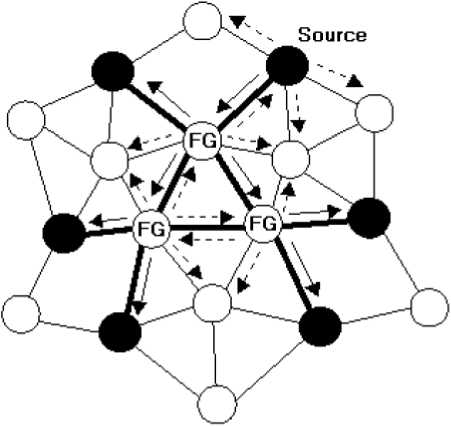

Multicast Member Node
(EG! Forwarding Group Node
Link
Multicast Mesh Link
¼ Traffic Flow
TrafficOverhead
Figure 2.9 Data Forwarding in ODMRP[64].
2.4.7.2 Core Assisted Mesh Protocol (CAMP)
CAMP [27] extends the receiver-initiated approach for Core Based Tree (CBT) [6] to form a
multicast mesh. It also builds and maintains a multicast mesh for distributing information
within each multicast group. A multicast mesh is a set of nodes within the network topology
that insures at least a path from the source to each receiver. Within the multicast mesh of a
group, CAMP guarantee forwarding data from any source in the group along the reverse
shortest path to the source. One or more cores can be defined for each mesh. CAMP uses
cores to limit the traffic required for a node needs to join the multicast group. CAMP
provides loop-free packet forwarded over meshes.
CAMP [27] is considered the first multicast protocol that uses routing structure other than
tree structure [28]. One possible disadvantage of CAMP is that it needs an underlying unicast
protocol like WRP [50] for providing unicast routes to all destinations in the network.
29
More intriguing information
1. Institutions, Social Norms, and Bargaining Power: An Analysis of Individual Leisure Time in Couple Households2. BILL 187 - THE AGRICULTURAL EMPLOYEES PROTECTION ACT: A SPECIAL REPORT
3. Studies on association of arbuscular mycorrhizal fungi with gluconacetobacter diazotrophicus and its effect on improvement of sorghum bicolor (L.)
4. Investment and Interest Rate Policy in the Open Economy
5. The name is absent
6. Needing to be ‘in the know’: strategies of subordination used by 10-11 year old school boys
7. The name is absent
8. The name is absent
9. Barriers and Limitations in the Development of Industrial Innovation in the Region
10. Types of Cost in Inductive Concept Learning